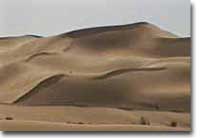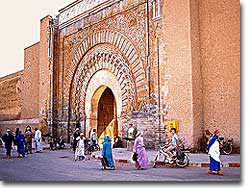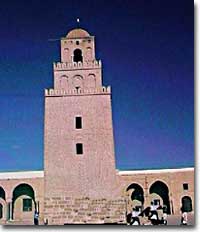7e. Life on the Desert

Only around 20% of the Sahara looks like this sterotypical desert; the rest is rocky desert or has small amounts of brush. But that 20% is still larger than a quarter of the entire United States.
"There's no place like home." To the Bedouin people, this "home" meant the entire Sahara desert.
Traditional Bedouin are pastoral nomads, or wanderers who travel with herds of domesticated animals. They are constantly on the move, with no permanent camping place. Their staple belongings include camels and tents, and they frown upon agriculture and all types of trades and crafts. Any type of settled life is traditionally considered beneath Bedouin dignity.
While it may seem like the Bedouin lack order, this is far from true. Tribes are the basic unit of their social organization, and though simple, they are highly structured. For wandering purposes, tribes break into smaller clans and family units. Traveling and exploiting the land is much more efficient this way.
Most of what is known about the Bedouin today involves Middle Eastern tribes and lands, but it is important to recognize that much of Bedouin history also took place in northern Africa. In fact, the Sahara was one of the first Bedouin territories.
Islam Comes to Africa
The first Arab invasion of North Africa was led by ancestors of the Bedouin and occurred in 643 C.E. At the time of the invasion, northern Africa already had a long history of foreign attack and cultural infusion. The Greeks, Romans, and Phoenicians had previously left their marks, and it was time for the Arab Muslims to do the same.

The traditional desert city is walled for defense, as the flat desert provides no natural barriers. Walls have gates, which are points of access to the city. Here you see that the walls of Marrakech are fortress-like, often 20 to 30 feet thick and 30 to 40 feet high.
Followers of the prophet Muhammad emerged from the Arabian Peninsula and moved westward across Berber-occupied areas of northern Africa. Their goals were to teach the fundamentals of Islam and establish regional, political, and religious unity under the rule of a Muslim leader, or caliph.
The invasion was intense, and by the 8th century, the primary goals were accomplished. Muslims had succeeded in saturating the region, but they had also encountered internal conflict that led to big changes. Hostile disagreement between two Arab leaders had divided Islam into two branches — Sunni and Shia.
A long chain of events resulted from this division, and one important link led to the invasion of the Bedouin. Around 1040 C.E., a group of Islamicized Berbers who had become affiliated with the Shia decided to take revenge. They neglected lands given to them by their caliph, defied the creeds of the Shia, and launched a rebellion among other Berbers to convertto the Sunni branch.
These events no doubt led to vengeful reactions. The angry Shia caliph invited two tribes of Arabian Bedouin, known collectively as the Hilalians, to travel west and issue the Berbers' punishment.

A view of the minaret of the Great Mosque at Kairouan, Tunisia. Minarets are towers in mosques from which Muslims are called to prayer five times each day. Kairouan is said to be the fourth holiest city in Islam.
Invasion and Arabization
The Bedouin groups agreed to the task and carried it out well. They moved in aggressively, making their way mercilessly through Egypt and Libya — and some even continued on to the coast of Morocco. This was their chance to acquire new territory through conquest.
The Hilalian invasion was devastating to the region. The Bedouin and their herds left little behind. Towns were quickly demolished. Great cities were sacked and literally trampled to dust. Farmlands were defaced. Some Berbers eventually decided to join the Bedouin invaders — they obviously could not beat them, so this was probably a survival choice.
The Bedouin invasion of northern Africa was obviously one of destruction, but it was also one of introduction. As the nomads swept through the region, they continued the process of Arabization — the teaching and spreading of Islamic culture.
The early Bedouin left behind much more than a good story. They left the ideals of strength and endurance that have allowed their culture and peoples to survive today. Modern Bedouin tribes have been forced over the years to adapt to modern conditions. Gradually they have become more sedentary, but their foundation of pastoral nomadism is still firm and the desert is still the place they call home.







